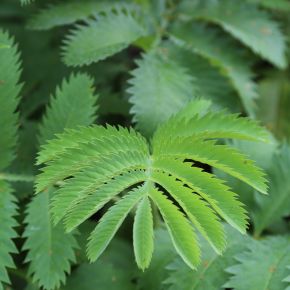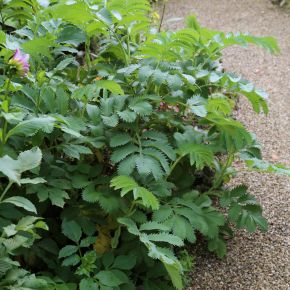Melianthus major
(Honey Bush)
Family - Melianthaceae
Category - Shrub, perennial
Origin - South Africa
Year of Introduction - 1688
Season of Interest - Spring, Summer, Autumn
Hardiness - H3
Height - 1.5m - 2m
Width - 1m, possibly more
Location - The Exotic Garden
Description: Small to medium-sized Shrub with an upright, bushy habit. Attractive, blue-green to grey-green leaves are pinnate with Elliptic to ovate leaflets that are heavily toothed around the margins. The foliage smells of peanut butter when crushed. In mild climates, upright Racemes of deep red, nearly brown, flowers are produced from late spring into midsummer. (Flowers are not likely to be produced at Malverleys.) Melianthus major is an Evergreen Shrub in mild climates, but is treated as a herbaceous Perennial at Malverleys, where the foliage is killed by frost each year, though new growth is produced in the spring.
Award of Garden Merit (AGM).
Additional common name - Honey Flower.
Flower:
Nectar-rich, deep red flowers are nearly brown and produced in upright racemes from May into July. Flowers are only produced in areas where the foliage is not killed to the ground by frost each year. Flowers are not likely to be produced at Malverleys.
Flower colour: Red
Flower shape: Tubular flowers in racemes
Flowering time: May, June, July
Foliage:
Blue-green to grey-green leaves have Elliptic to ovate leaflets that are jaggedly toothed at the margins. The foliage smells of peanut butter when crushed. Melianthus major is Evergreen in mild climates, but the leaves are killed by frost each year at Malverleys, though the plants will produce fresh, new growth each spring.
Foliage Senescence: Evergreen to deciduous
Foliage Shape: Pinnate with elliptic to ovate leaflets
Pest and Diseases:
If growing under glass, whitefly control may be necessary.
Propagation:
Cuttings, division, seed.
Cultivation:
Best in a sheltered position in full sun. Melianthus major prefers reasonably fertile, moisture retentive soil that is well drained. Avoid excessive winter wet where possible.

